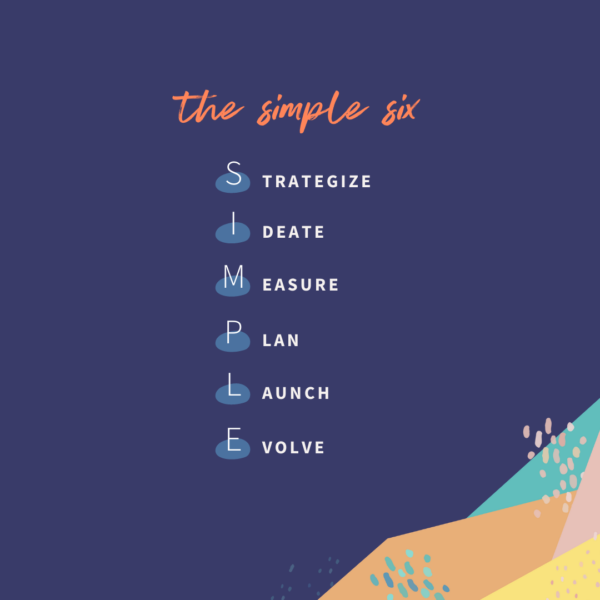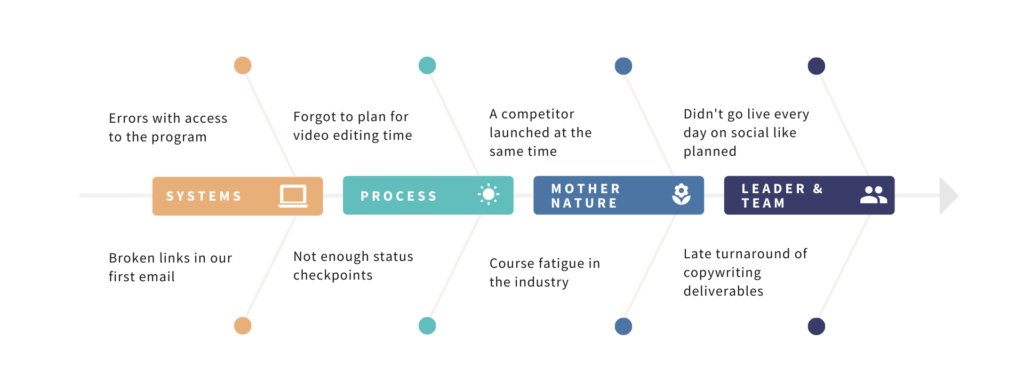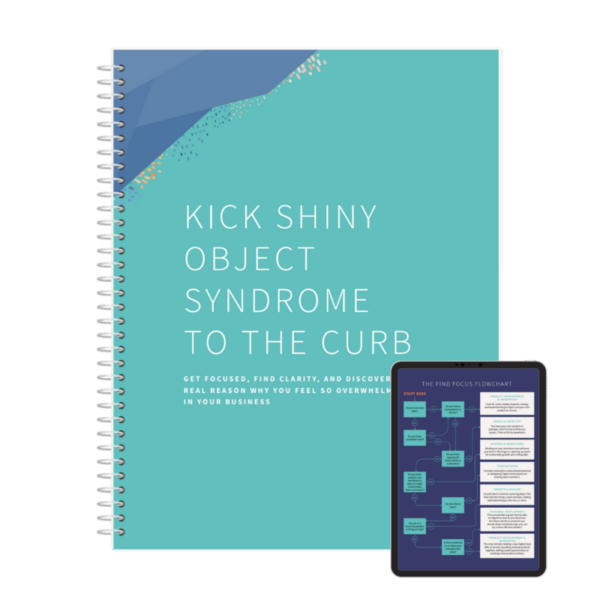Let’s set the stage: You’ve put all your effort into launching that new product, scaling your services, or streamlining your sales funnel. You did everything right (you thought), and you’re proud of the result. But it’s not working.
Your audience isn’t buying that new offer, your services feel as disjointed as ever, or your sales funnel isn’t converting as well as you’d want. Whatever your particular pain point is right now, it’s frustrating. Odds are, there’s a vital component missing from your latest project or effort, and we can pinpoint where that component is by using the Simple Six.
Using the Simple Six to evaluate launch mistakes & project management improvements
The Simple Six process is a project management framework that I use with my clients to help support their projects with clear steps and progression. It can also help you pinpoint where you went wrong — by reviewing your projects in retrospect. This is where you really assess what happened, from start (Strategize) to finish (Launch).

What went wrong with the strategy?
For example, let’s say you want to launch that new product I mentioned above. I’ll let your imagination fill in what type of product.
Believe it or not, “Launch the new product” isn’t a strategic goal. A strategic goal is something like “Build the email list by 2,000 subscribers before launching the new product,” or “Launch the new product in Q2, to drive $10,000 in revenue during our slow season.”
Do you see the difference? This is usually where I see most online business owners go wrong — because they have a goal to do something, but no strategy behind when or how or even why.
So I ask you: Did you enter this project with a strong strategy? Or was that missing from the start?
Did something go wrong during ideation?
Usually, when you launch a new product, course, or offer and get *crickets*, you assume that people just don’t want what you created. Before you go and toss it in the digital bin, let’s take a minute. Ask yourself:
- Did you vet the offer/idea before creating it?
- Did you get feedback from others before launching it?
- Was this based on a conversation or request from a client/customer?
If you did all of that, it might not be that your idea sucks. The breakdown could be in the delivery or messaging. Now, let’s think about your brainstorming process for actually marketing the new offer.
- Did you ask customers/clients for their input to truly gather your Voice of Customer… or did you decide to take a question from one single client or customer and leap straight to it needing to be a full-blown product?
- Did you allow beta testers to offer feedback and testimonials?
- Did you get much engagement from emails or other content you used to promote the offer?
- Did you think about unique ways to share the product, or get the word out?
What did you measure?
In this phase of a project, you’re supposed to choose which metrics to monitor. In the example of a new product launch, you’d want to track things like:
- Subscriber count
- Facebook ad clicks and conversions
- Sales page conversions
- Email open and click-through rate
To know if the launch was successful, you’d need to monitor those metrics in real-time and make adjustments.
If your subscriber count wasn’t going up, maybe you needed to promote your freebie or offer value somewhere else, before pitching your new product. If your Facebook ads weren’t getting clicks, it might have been a targeting issue, or lackluster graphics or copy. If your sales page wasn’t converting, you know the offer wasn’t enticing enough — or there may be concerns about pricing. If your emails promoting your new product weren’t even getting opened, you know you need to re-engage and maybe even trim your list for better engagement next time.
All of these metrics can show you clearly what wasn’t working… but you have to choose them before the project is done!
Did you choose metrics during your project? If so, which ones are your problem children? If not, which ones will you choose to monitor on your next launch?
Where did the plan go off the rails?
During the plan phase of launching your hypothetical product, you have to pay attention to every detail. What content will you create to provide value leading up to the launch, and then to promote the launch? What tech setup will you need? Do you need to have a social media marketing plan? Who will manage the launch? How are you automating delivery?
All of this is critical if you want to avoid chaotic launch weeks, and have an effective launch.
If you felt like product launch tasks were always late or like you didn’t stay present on social media or email enough prior to launching, this is probably the phase you need to re-evaluate. You’ll want to consider things like timelines, your runway (how you take people along for the ride!), the tech, your team members or contractors, and more.
How’d the launch go?
Launching is the fun part, especially if you’re a visionary CEO. You want to get the shiny new thing out there — maybe even presell it or only build out part of the product before getting people in the door. I have clients who do this all the time. While it’s a great way to test a product before investing tons of time and money into creating all of it, it can also lead to a hectic and confusing launch. For you, your team, and your buyers.
If you’re creating the product at the same time that you’re launching it, you’re going to hit burnout FAST. So many business owners get excited about their latest and greatest only to fall flat in energy because they tried to pull the cart (launch) before the horse (product). The most critical time for customer satisfaction is immediately after purchase—don’t spend all your time on the launch and none of it on the first few interactions with you. Create a realistic plan upfront that accounts for product development and launch marketing.
From there, you also need to evaluate: Did you leave strategic goals, metrics, and timelines for “next time, when you know it will sell?” And when you did launch, did it feel pieced together? Did you change things like bonuses, cart close dates, or what was included in the purchase? Was your messaging consistent throughout? Or did you kind of try a little bit of everything to see if it would resonate with one person and then switch it up for the next?
There’s also the element of monitoring your launch. Did you check in with your metrics and see how things were going? Did you evaluate pain points and attempt to make tweaks to things like social media strategy or Facebook ads? Did you build in time or resources to help with customer support or troubleshooting?
Take a look at how the launch really went, and ask your contractors or team members, too. They’ll point out the places where things didn’t go smoothly, or where they’d like to improve next time.
How can this project evolve and get better?
The last phase of the Simple Six is “Evolve.” Spoiler alert: That’s exactly what we’re doing right now. We’re reviewing the project, identifying pain points, and also being honest with what we did and didn’t do.
During this process, you may find that one or two things affected the outcome of your launch or most recent project — and that’s OK. It happens even on teams where I use the Simple Six ahead of the project’s start. It’s just information that you can use to improve, not information to make you feel bad.
Part of this “Evolve” process is to review each of the other five phases of the Simple Six. I have a handy diagram here that can help you. It’s called a Fishbone diagram and the primary purpose is to help you discover the root causes behind a problem. Here, I’m using it to evaluate hiccups during a hypothetical launch.

Find what’s next — strategically
I know that deciding to invest time, money, and energy into something after you’ve had a recent flop or failure can be hard. The truth is, though, that every business grows from successes and failures. As my friend Yasmine Spencer and I talk about all the time on our Pixie Dust & Profits podcast, even the Walt Disney Company has failures and things that don’t go according to plan (Mars Needs Moms racked up $130 million in losses).
Each launch or project attempted helps you learn something new. That information can be used to strengthen those same products or initiatives, and even show you a more strategic or impactful idea that you hadn’t seen before.
My biggest recommendation to you is to focus on the strategic plans, products, and projects that are actually going to move the needle forward in your business. No more throwing stuff at the wall to see what sticks, and no more rushing out your latest-and-greatest idea without attention to the finer details.
You can decide which projects are worth your time, money, and energy by using my strategic pillars resource. This will show you the six areas your projects may fall into, and which ones need the most attention and resources right now. Then, once you have your strategic projects planned (spoiler alert: this is the Strategize phase of the Simple Six), you can finish the remaining five steps in the framework.
As I’ve said before: Do the work to strategize, ideate, measure, and plan your launches or projects before they’re underway. You’ll be better able to see when things aren’t going the way you want them to and adjust course.
Don’t give up. Keep trying and keep learning — with strategy in mind, of course.

[…] our friend Nicole Boucher puts it, you need to review what went well (and what didn’t) during your last launch or promo. […]